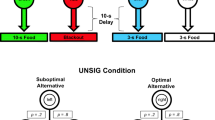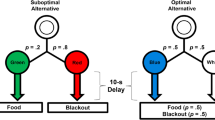Abstract
In an analog of human gambling, pigeons prefer a suboptimal alternative that infrequently provides a signal that is reliably associated with reinforcement over the more optimal alternative that yields more reinforcement. We hypothesized that pigeons are sensitive to the conditioned reinforcement that accrues to the stimulus associated with the greatest probability of reinforcement, independent of the frequency of its occurrence. In the present experiment we tested that hypothesis in a between groups design. For Group 50/75, choice of the suboptimal alternative 50 % of the time resulted in presentation of a stimulus that was always associated with reinforcement. For Group 25/75, choice of the suboptimal alternative 25 % of the time resulted in presentation of a stimulus that was always associated with reinforcement. For both groups, choice of the optimal alternative always resulted in presentation of a stimulus associated with 75 % reinforcement. In support of our hypothesis, both groups chose suboptimally and at the same rate. These results suggest that the conditioned reinforcing properties of the signal for reinforcement are acquired through its reliability as a signal for reinforcement and the frequency of its occurrence is of little importance.



Similar content being viewed by others
References
Belke, T. W., & Spetch, M. L. (1994). Choice between reliable and unreliable reinforcement alternatives revisited: preference for unreliable reinforcement. Journal of the Experimental Analysis of Behavior, 62, 353–366.
Blanco, C., Ibáñez, A., Sáiz-Ruiz, J., Blanco-Jerez, C., & Nunes, E. (2000). Epidemiology, pathophysiology and treatment of pathological gambling. CNS Drugs, 13, 397–407.
Cohen, J. (1988). Statistical power analysis for the behavioral sciences (2nd ed.). Hillsdale: Lawrence Erlbaum Associates.
Dinsmoor, J. A. (1983). Observing and conditioned reinforcement. The Behavioral and Brain Sciences, 6, 693–728.
Fantino, E. (1969). Choice and rate of reinforcement. Journal of the Experimental Analysis of Behavior, 12, 723–730.
Fantino, E., Dunn, R., & Meck, W. (1979). Percentage reinforcement and choice. Journal of the Experimental Analysis of Behavior, 32, 335–340.
Gallistel, C. R. (2009). The importance of proving the null. Psychological Review, 116, 439–453.
Gipson, C. D., Alessandri, J. D., Miller, H. C., & Zentall, T. R. (2009). Preference for 50 % reinforcement over 75 % reinforcement by pigeons. Learning & Behavior, 37, 289–298.
Laude, J. R., Beckmann, J. S., Daniels, C. W., & Zentall, T. R. (2014a). Impulsivity affects gambling-like choice by pigeons. Journal of Experimental Psychology. Animal Behavior Processes, 40, 2–11.
Laude, J. R., Stagner, J. P., & Zentall, T. R. (2014b). Suboptimal choice by pigeons may result from the diminishing effect of nonreinforcement. Journal of Experimental Psychology. Animal Behavior Processes, 40, 12–21.
Mazur, J. E. (1996). Choice with certain and uncertain reinforcers in an adjusting delay procedure. Journal of the Experimental Analysis of Behavior, 66, 63–73.
Roper, K. L., & Zentall, T. R. (1999). Observing behavior in pigeons: the effect of reinforcement probability and response cost using a symmetrical choice procedure. Learning and Motivation, 30, 201–220.
Rouder, J. N., Speckman, P. L., Sun, D., Morey, R. D., & Iverson, G. (2009). Bayesian t tests for accepting and rejecting the null hypothesis. Psychonomic Bulletin & Review, 16, 225–237.
Spetch, M. L., Belke, T. W., Barnet, R. C., Dunn, R., & Pierce, W. D. (1990). Suboptimal choice in a percentage-reinforcement procedure: effects of signal condition and terminal link length. Journal of the Experimental Analysis of Behavior, 53, 219–234.
Spetch, M. L., Mondloch, M. V., Belke, T. W., & Dunn, R. (1994). Determinants of pigeons’ choice between certain and probabilistic outcomes. Animal Learning & Behavior, 22, 239–251.
Stagner, J. P., Laude, J. R., & Zentall, T. R. (2012). Pigeons prefer discriminative stimuli independently of the overall probability of reinforcement and of the number of presentations of the conditioned reinforcer. Journal of Experimental Psychology. Animal Behavior Processes, 38, 446–452.
Stagner, J. P., & Zentall, T. R. (2010). Suboptimal choice behavior by pigeons. Psychonomic Bulletin & Review, 17, 412–416.
Zentall, T. R., & Stagner, J. P. (2011a). Maladaptive choice behavior by pigeons: an animal analog of gambling (sub-optimal human decision making behavior). Proceedings of the Royal Society B:Biological Sciences, 278, 1203–1208.
Zentall, T. R., & Stagner, J. P. (2011b). Sub-optimal choice by pigeons: failure to support the Allais paradox. Learning and Motivation, 42, 245–254.
Author information
Authors and Affiliations
Corresponding author
Rights and permissions
About this article
Cite this article
Zentall, T.R., Laude, J.R., Stagner, J.P. et al. Suboptimal Choice by Pigeons: Evidence that the Value of the Conditioned Reinforcer Rather than its Frequency Determines Choice. Psychol Rec 65, 223–229 (2015). https://doi.org/10.1007/s40732-015-0119-2
Published:
Issue Date:
DOI: https://doi.org/10.1007/s40732-015-0119-2




